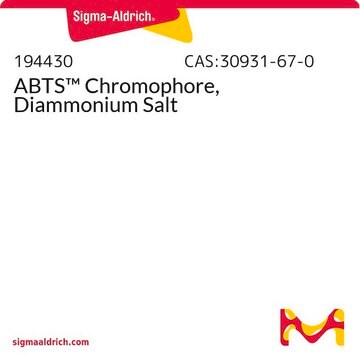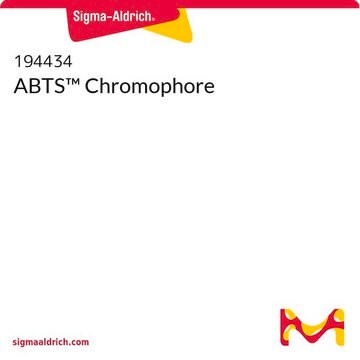11557
2,2′-Azino-bis(3-ethylbenzothiazolin-6-sulfonsäure) Diammoniumsalz
chromogenic, ≥98% (HPLC), powder or crystals
Synonym(e):
AzBTS-(NH4)2
About This Item
Empfohlene Produkte
product name
2,2′-Azino-bis(3-ethylbenzothiazolin-6-sulfonsäure) Diammoniumsalz, ≥98% (HPLC)
Assay
≥98% (HPLC)
Form
powder or crystals
Verunreinigungen
≤6.0% water
Löslichkeit
H2O: 10 mg/mL, slightly hazy to clear
Lagertemp.
2-8°C
SMILES String
[NH4+].[NH4+].CCN1C(\Sc2cc(ccc12)S([O-])(=O)=O)=N\N=C3/Sc4cc(ccc4N3CC)S([O-])(=O)=O
InChI
1S/C18H18N4O6S4.2H3N/c1-3-21-13-7-5-11(31(23,24)25)9-15(13)29-17(21)19-20-18-22(4-2)14-8-6-12(32(26,27)28)10-16(14)30-18;;/h5-10H,3-4H2,1-2H3,(H,23,24,25)(H,26,27,28);2*1H3/b19-17-,20-18-;;
InChIKey
OHDRQQURAXLVGJ-AXMZSLBLSA-N
Suchen Sie nach ähnlichen Produkten? Aufrufen Leitfaden zum Produktvergleich
Anwendung
- im Radikalfänger-Assay zur Prüfung der antioxidativen Eigenschaft von Pinus-densiflora-Rindenextrakten (PDB-Extrakten)
- zur Prüfung der antioxidativen Kapazität (AOC) von Aloe-Vera-Proben
- als Substrat für Streptavidin-Meerrettichperoxidase (HRPO) im Enzymimmunoassay (ELISA)
Sonstige Hinweise
Lagerklassenschlüssel
11 - Combustible Solids
WGK
WGK 3
Flammpunkt (°F)
Not applicable
Flammpunkt (°C)
Not applicable
Persönliche Schutzausrüstung
dust mask type N95 (US), Eyeshields, Gloves
Analysenzertifikate (COA)
Suchen Sie nach Analysenzertifikate (COA), indem Sie die Lot-/Chargennummer des Produkts eingeben. Lot- und Chargennummern sind auf dem Produktetikett hinter den Wörtern ‘Lot’ oder ‘Batch’ (Lot oder Charge) zu finden.
Besitzen Sie dieses Produkt bereits?
In der Dokumentenbibliothek finden Sie die Dokumentation zu den Produkten, die Sie kürzlich erworben haben.
Kunden haben sich ebenfalls angesehen
Unser Team von Wissenschaftlern verfügt über Erfahrung in allen Forschungsbereichen einschließlich Life Science, Materialwissenschaften, chemischer Synthese, Chromatographie, Analytik und vielen mehr..
Setzen Sie sich mit dem technischen Dienst in Verbindung.








